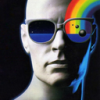 Submitted by Sci Fi Guy on
Submitted by Sci Fi Guy on
Strange Loops - A guided tour through Douglas Hofstadter's paradoxical concept of 'strange loops', and what they reveal about the ultimate nature of existence and consciousness.
A strange loop is a cyclic structure that goes through several levels in a hierarchical system. It arises when, by moving only upwards or downwards through the system, one finds oneself back where one started.
Strange loops may involve self-reference and paradox.
The concept of a strange loop was proposed and extensively discussed by Douglas Hofstadter in Gödel, Escher, Bach, and is further elaborated in Hofstadter's book I Am a Strange Loop, published in 2007.
A tangled hierarchy is a hierarchical consciousness system in which a strange loop appears.
A strange loop is a hierarchy of levels, each of which is linked to at least one other by some type of relationship. A strange loop hierarchy is "tangled" (Hofstadter refers to this as a "heterarchy"), in that there is no well defined highest or lowest level; moving through the levels, one eventually returns to the starting point, i.e., the original level. Examples of strange loops that Hofstadter offers include: many of the works of M. C. Escher, the Canon 5. a 2 from Bach's Musical Offering, the information flow network between DNA and enzymes through protein synthesis and DNA replication, and self-referential Gödelian statements in formal systems.
In I Am a Strange Loop, Hofstadter defines strange loops as follows:
And yet when I say "strange loop", I have something else in mind — a less concrete, more elusive notion. What I mean by "strange loop" is — here goes a first stab, anyway — not a physical circuit but an abstract loop in which, in the series of stages that constitute the cycling-around, there is a shift from one level of abstraction (or structure) to another, which feels like an upwards movement in a hierarchy, and yet somehow the successive "upward" shifts turn out to give rise to a closed cycle. That is, despite one's sense of departing ever further from one's origin, one winds up, to one's shock, exactly where one had started out. In short, a strange loop is a paradoxical level-crossing feedback loop. (pp. 101-102)
Strange loops take form in human consciousness as the complexity of active symbols in the brain inevitably leads to the same kind of self-reference which Gödel proved was inherent in any complex logical or arithmetical system in his incompleteness theorem.[1] Gödel showed that mathematics and logic contain strange loops: propositions that not only refer to mathematical and logical truths, but also to the symbol systems expressing those truths. This leads to the sort of paradoxes seen in statements such as "This statement is false," wherein the sentence's basis of truth is found in referring to itself and its assertion, causing a logical paradox.[2]
Hofstadter argues that the psychological self arises out of a similar kind of paradox. We are not born with an "I" – the ego emerges only gradually as experience shapes our dense web of active symbols into a tapestry rich and complex enough to begin twisting back upon itself. According to this view the psychological "I" is a narrative fiction, something created only from intake of symbolic data and its own ability to create stories about itself from that data. The consequence is that a perspective (a mind) is a culmination of a unique pattern of symbolic activity in our nervous systems, which suggests that the pattern of symbolic activity that makes identity, that constitutes subjectivity, can be replicated within the brains of others, and perhaps even in artificial brains.[2]
The "strangeness" of a strange loop comes from our way of perception, because we categorize our input in a small number of "symbols" (by which Hofstadter means groups of neurons standing for one thing in the outside world). So the difference between the video-feedback loop and our strange loops, our "I"s, is that while the former converts light to the same pattern on a screen, the latter categorizes a pattern and outputs its essence, so that as we get closer and closer to our essence, we get further down our strange loop.[3]
Hofstadter thinks our minds appear to us to determine the world by way of "downward causality", which refers to a situation where a cause-and-effect relationship in a system gets flipped upside-down. Hofstadter says this happens in the proof of Gödel's incompleteness theorem:
Merely from knowing the formula's meaning, one can infer its truth or falsity without any effort to derive it in the old-fashioned way, which requires one to trudge methodically "upwards" from the axioms. This is not just peculiar; it is astonishing. Normally, one cannot merely look at what a mathematical conjecture says and simply appeal to the content of that statement on its own to deduce whether the statement is true or false. (pp. 169-170)
Hofstadter claims a similar "flipping around of causality" appears to happen in minds possessing self-consciousness. The mind perceives itself as the cause of certain feelings ("I" am the source of my desires), while according to popular scientific models, feelings and desires are strictly caused by the interactions of neurons.
1. Johnson, George (March 2007). "A New Journey into Hofstadter's Mind". Scientific American. Retrieved 8 October 2011.
2. O'Reilly, Scott (2010). "I Am A Strange Loop by Douglas Hofstadter". PhilosophyNow. Retrieved 8 October 2011.
3. Hofstadter, Douglas (2007). I Am A Strange Loop. ISBN 978-0-465-03078-1.